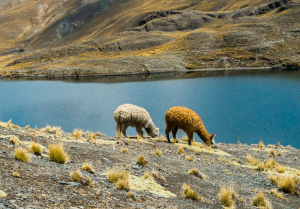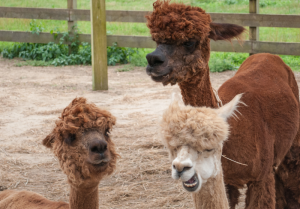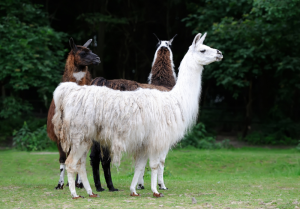Leaving Alpacas Out In The Rain
Since alpacas are native to a part of the world famous for rainforests, and since alpaca wool is often marketed as being waterproof, one might think that alpacas would be right at home in the rain. But this is not the case.
Can you leave alpacas out in the rain? Alpaca fiber is not waterproof, and alpacas can get sick if they are exposed to too much rain. Alpacas can suffer from hypothermia, rain rot, and a reduction in the quality of their fiber if they spend too much time in the rain. It’s important to provide them with adequate shelter so they can escape the rain.
Even if you live in a part of the world that gets a lot of rain, there is still hope for your alpacas. Read on for a better understanding of how much water alpacas can safely handle.
Alpacas Come From A Rainy Climate 
Alpacas originate from South America, particularly the Andes mountain area and Chile. They are accustomed to high elevations and can live comfortably in cold and hot weather. Weather conditions in their natural habitats are often harsh, but alpacas have developed the capacity to handle these conditions well.
However, since they are not capable of shedding their fleece, they rely on having their wool shorn every year and on having the right kind of shelter throughout the different seasons and depending on the length and resulting warmth of their fleece.
There are a lot of wetlands on and around the Andes mountains, and alpacas have been known to step in the water, even going deep enough to swim. If your alpacas have access to a pond or other body of water on your property, don’t be surprised if they take a tip on warm days. If that’s not possible for you, you can even consider providing a couple of kiddie pools full of water to give them the chance to lay in the water to cool off throughout the day.
But alpacas don’t enjoy being rained on. A shelter is definitely necessary to keep your alpacas dry and warm in the rain.
Alpaca Health Problems from Cold and Wet Conditions
Hypothermia
All alpacas, but especially newborns and geriatric individuals, are in danger of becoming hypothermic in extremely cold and wet conditions. This can be fatal if not recognized and addressed in time. The colder the alpacas become, the less energy they have to move around, and the more likely they are to become too weak to get to food and eat and move around to warm up enough in order to survive the event.
Hypothermia is still a risk even if you have a quality shelter in place. If the temperature drops low enough, it may become necessary to provide extra heat in the form of electric heaters. You can also put blankets over them as one does for horses in the winter. Providing thick straw as bedding in the shelter will provide additional insulation and especially help them keep their legs warm when they lay down in it.
If you find an alpaca experiencing hypothermia, take immediate action to warm the animal. Be careful to warm them slowly by providing some heat and blankets. Warming an animal too quickly can cause its body temperature to get dangerously high before you realize it, which can cause other problems of its own. Alpacas recovering from hypothermia may need to have food brought to them or even be syringe fed temporarily as they build up enough strength to get up and find food on their own again.
Dermatophilosis (Rain Rot)
Dermatophilosis, also referred to as “dermo,” is uncommon in alpacas. But it is a bacterial infection of the skin that happens when an animal has been chronically exposed to wet conditions without proper shelter.
One of the draws of alpaca fiber is that it is water-resistant. This is a great quality that both the alpacas and the humans wearing alpaca wool products benefit from. But water resistance is not the same as being waterproof. Waterproof means that the substance is impenetrable to water. Water-resistant means that the substance will resist water for a time but will eventually suffer the consequences of continued water exposure.
Because alpaca fiber is only water-resistant, rainwater will eventually get down to its skin. And if it sits there for a long time, bacteria will flourish and cause sores in their skin.
Fortunately, this is a very rare occurrence in alpacas and requires truly horrible wet conditions to become an issue. You can easily prevent this skin disease by providing a large enough shelter for your whole herd to fit in comfortably and by keeping an extra close eye on your herd when conditions are rainier than usual to ensure that everyone is keeping relatively dry.
If you suspect that your alpaca may have developed this health condition, seek veterinary advice before trying anything yourself. A vet can confirm what the problem actually is and suggest the safest and most beneficial treatment.
Does Water Affect Alpaca Fiber Quality?
Yes. Too much exposure to water can reduce the quality of alpaca fiber. As long as your alpacas stay dry most of the time, their fibers should retain their quality. It takes a lot of water exposure to degrade the wool, and the animal’s health would become a greater concern than the quality of the fiber at that point.
How To Keep Alpacas Safe In The Rain
Provide the Best Possible Shelter for Your Alpacas
Alpacas usually do best either with a barn for shelter or a three-sided structure they can easily come and go from as they please. Ensure that the boards are close enough together to prevent wind or rain from blowing into the structure. And Consider shingling the roof for the best chance of preventing leaks.
Straw makes a great bedding choice as it holds heat well and will warm the alpacas further when they lay down in it.
What If Alpacas Won’t Come Inside from the Rain? 
If your alpacas refuse to enter the shelter despite the rain, you should pay attention to this and find out why. It could be because it’s light rain in warm weather. If so, the rain might not bother the alpacas enough for them to seek shelter. It is normal for alpacas to stay outside where they can enjoy their personal space and graze to their hearts’ content as much as possible.
But this behavior could also be an indicator of a problem with the shelter you’ve provided. Because alpacas do prefer to have their personal bubble, some could avoid a shelter that doesn’t allow them to maintain it, even at the expanse of getting soaked and being too cold.
Some individuals with less insistent personalities could also be kicked out of a small shelter by the more assertive members of the herd and have no choice but to be cold and wet.
This is a situation best avoided. In this case, expanding the shelter or even providing an additional shelter could help eradicate this problem. It would be best to do so as soon as possible to prevent the physical and emotional stress on alpacas who are unable to get space to stay dry in the current conditions.
Consider Other Animals Better Suited to Your Climate
Lastly, if you live in an extremely wet or cold part of the world, consider whether alpacas are really the best choice for you based on your environment. Is it really possible to keep them appropriately dry and warm in the typical weather conditions of your area? Can you do so without incurring such an expense that keeping alpacas is no longer financially feasible?
If you determine that alpacas may not be the best choice for the area you live in, consider sheep or goats as other possibilities.
You can check out all of my latest articles here!

